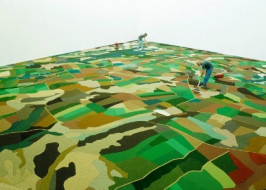"Field Theory"The Edna and K. B. Weissman Building of Physical Sciences, and the Nechemiah and Naomi Cohen Building1
The quest for knowledge is what unites humankind in a very deep way. Philosophers, theologians, artists and scientists – each wants to truly understand the rules of the game by which the “world” operates, how it will react to this or that action. On the way to understanding “our” world, physicists examine many different “worlds.” Some of these are completely theoretical, but each of them can teach us something about the real world in which we live. One such system is called “Field Theory.”
The term “field” takes us back to an earlier existence: the farmer’s field, the source of bread and other sustenance, which grants us the ability to plan for the future. Indeed that ability led society to advance from hunter-gatherers to modern agriculturalists, amassing knowledge, power and property along the way; this, essentially, is what has enabled our planet to support (not necessarily equally) over seven billion people (and more every day).
The Field Theory exhibit, curated by Yivsam Azgad, includes works by Yadid Rubin, Zoya Cherkassky, Gal Weinstein, Nachama Hendel, Joseph Milo, Hanna Meron, Asi Dayan, Iris Yodvat, Moshe Shamir, Peter Weiner and others, in a cultural-literary-poetic mix of “fields” and their places in our lives.
Yadid Rubin walked through fields and tried to expose the roots of their life cycles: plowing, sprouting, growing, reaping. The field, according to Rubin, is a world with a set of “operating instructions” that he must decipher with his paintings. Peter Weiner exposes in his field paintings the “behavioral pattern” shown by the field over time. Zoya Cherkassky, in Colorado Beetle, sees the field as a thin, fragile shell that enables the existence of a natural world order, and she defends it.
As Pinhas Sadeh (sadeh means “field” in Hebrew) wrote in one of his journals not long before his death, walking in the open, fresh air in a field instills faith in the future; the happiness we get from uniting with nature belongs to something bigger and more powerful than us.









